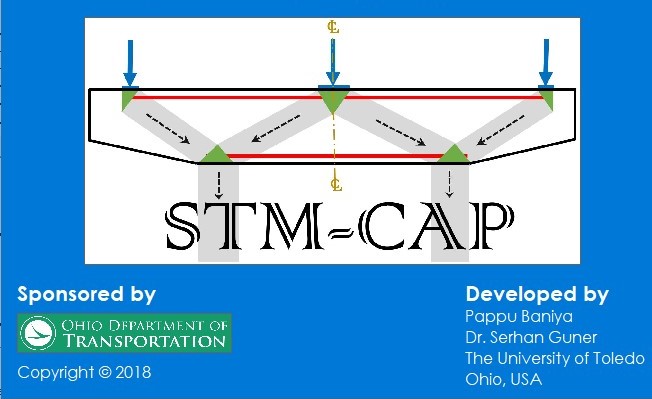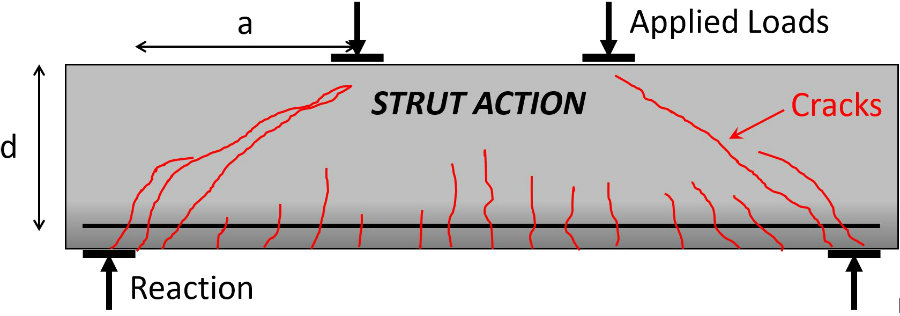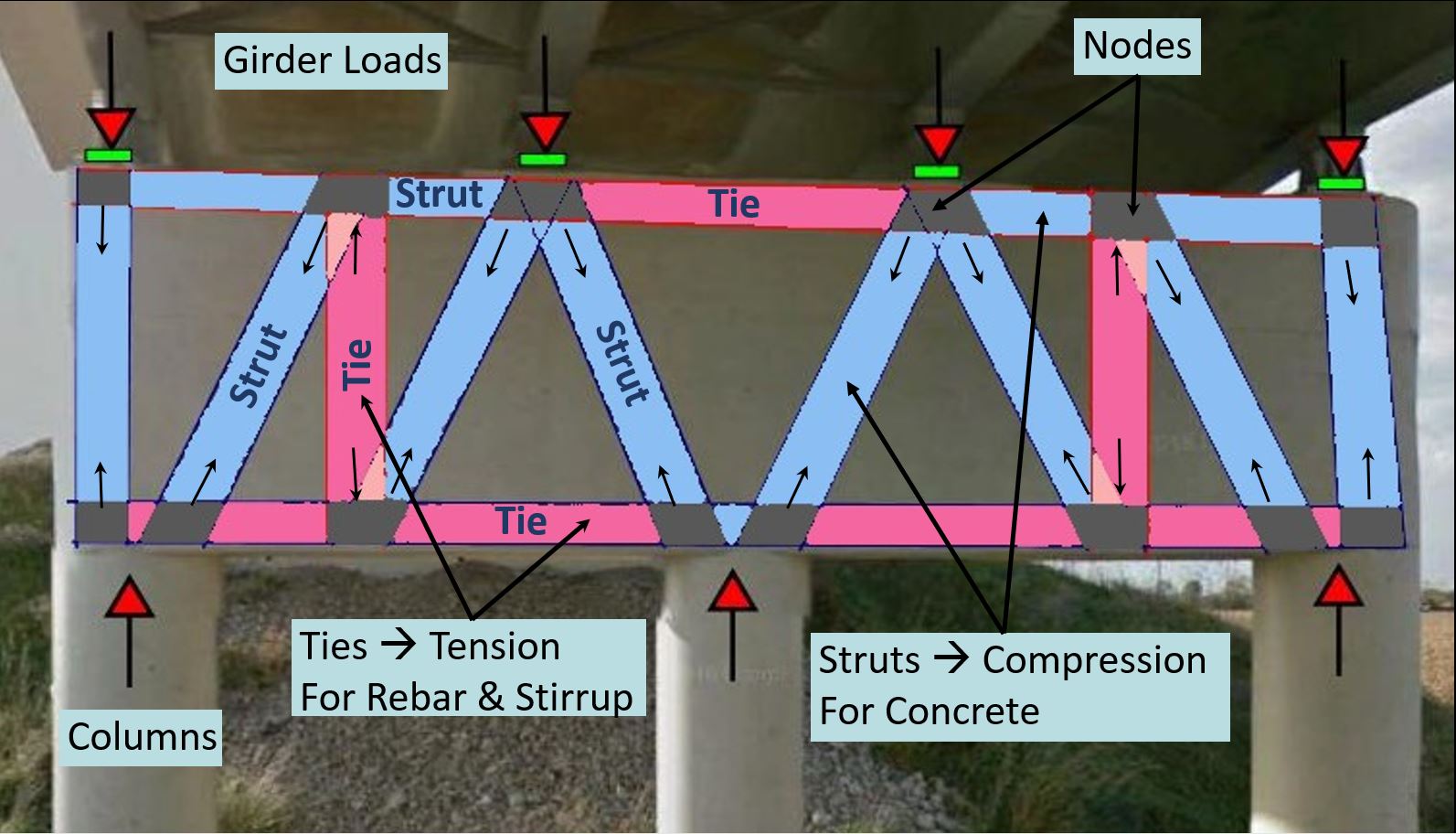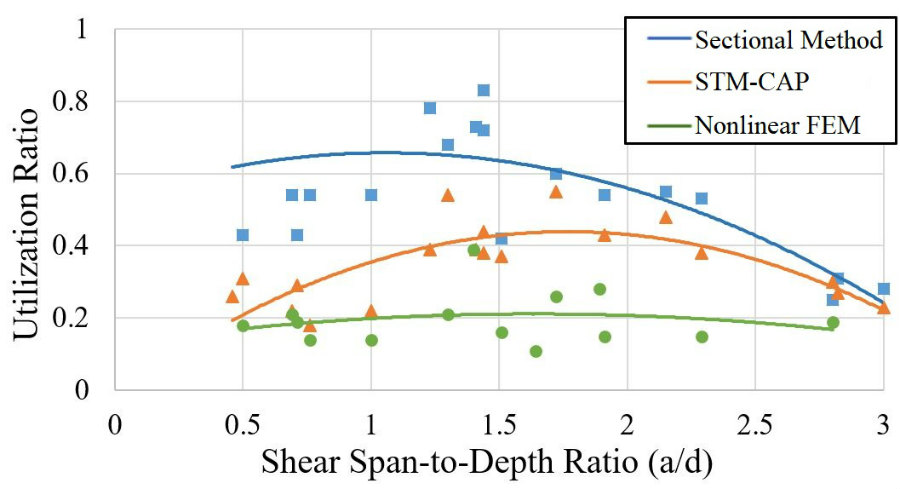RESIST Research Group
STM-CAP (Specialized Strut-and-Tie Method for Pier Caps)
 |
(Version 47, May 2020)STM-CAP is recommended in the latest version of the Ohio Bridge Design Manual. See C405.9. |
The objective of the STM-CAP program is to enable engineers to create efficient and valid strut-and-tie (STM) models while educating them on the correct use of the strut-and-tie methodology.
STM-CAP is a Visual Basic Advanced (VBA)-based program developed for the analysis of symmetrical and asymmetrical multi-column reinforced concrete pier caps under the ultimate load conditions. The program is embedded in Microsoft Excel to eliminate the need to install and learn new software. It is designed to perform strut-and-tie analysis for deep cap beams based on Article 5.8.2 of AASHTO LRFD 2017 while providing a graphical representation of the model to help the analyst better understand the system and identify potential input errors. STM-CAP is divided into several sections covering various aspects of the input parameters and analysis output results. STM-CAP uses factored loads and factored material resistances (i.e., performs an LFRD analysis). The limitations and the intended uses of the program are discussed in the ODOT final project report and the MS thesis of the first author, which are provided in the learning center below.
LEARNING CENTER
Project Documents and Tutorial Videos
The project report includes all details and solved examples in the appendices. The journal paper summarizes the important findings. Getting started and full modeling videos present hands-on examples.
Fact Sheet
The fact sheet provides a short and visual summary of the STM-CAP project, written in a project
summary format.
YOUTUBE TUTORIALSto our YouTube Channel to get the latest tutorial videos and more. STM-CAP MOTIVATION & BACKGROUND Understand the engineering problem that motivated us to create STM-CAP and learn more about strut-and-tie analysis and how it can benefit the engineering practice. Learn more STEP-BY-STEP METHODOLOGY In this short, 8-min video, learn about the step-by-step methodology behind the STM-CAP. Learn more STM-CAP ACCURACY & VERIFICATION In this video, learn about the accuracy of STM-CAP as compared to other analysis methods including nonlinear finite element and sectional analysis. Learn more |
BACKGROUND'Pier caps,' or 'bent caps', transfer the load from the girders to the columns. Pier caps are unique structures due to their short shear spans over which the girder loads are applied. A beam for which the distance between the applied load and the reaction point (a, in the figure below) is less than about twice the member depth (d, in the figure below) is referred to as a 'deep beam'. Most pier caps are 'deep beams,' which possess additional shear strengths due to the formation of the strut action. Unlike slender beams, deep beams transfer the shear forces to the supports through direct compressive struts rather than shear stresses. The diagonal cracks in deep beams eliminate the inclined principal tensile stresses required for the beam action and lead to a redistribution of internal stresses so that the beam acts as a tied arch, which is commonly referred to as the strut action. The AASHTO LRFD code started to include the deep beam analysis methods in 1994. Since the average age of the bridges in the United States is over forty years, most in-service bridges were not designed considering the deep beam effects and thus possess a hidden reserve shear capacity. The analysis methods used for the shear strength evaluation of bridges are typically based on the slender beam theory (i.e., the sectional analysis). This theory neglects the deep beam action and cannot capture the additional shear capacity. When analyzed by using the sectional methods, pier caps with sufficient shear strength may be incorrectly identified as structurally deficient. STM-CAP accounts for the deep beam action; therefore, it can more accurately determine the shear capacities and prevent unnecessary rehabilitation costs.
|
THEORETICAL APPROACHSTM-CAP is developed for the analysis of deep pier caps subjected to vertical girder loads. STM-CAP models the pier cap with a truss model consisting of ties, struts, and nodes (see the figure below). Ties represent the tension truss elements; struts represent the compressive truss elements; and nodes represents the connections in between them. STM-CAP considers two types of ties: horizontal ties for the main bars and vertical ties for the stirrup ties. The generated truss model can be further optimized by the user through the addition of vertical ties. The member forces for the STM truss model are determined using the matrix stiffness method considering uniform stiffness for each member. The capacity for each element is determined as per the AASHTO LRFD 2017 Bridge Design Specification. The nodal checks are performed for each member and the capacities are determined as the minimum of the member and its adjoining nodes. STM-CAP calculates the utilization ratio (i.e., the ratio of the member force to the member capacity) for each member to reflect the condition (i.e., either overloaded or reserve capacity). A utilization ratio of 0.80, for example, indicates that the pier cap has 80% of its capacity in use and has approximately 20% reserve capacity remaining. STM-CAP also indicates the governing failure mode and the location of the failure; thereby, facilitating efficient strengthening of pier caps at correct locations. |
METHODOLOGY VERIFICATIONThe figure below shows the utilization ratio predicted by STM-CAP and the sectional method for 21 regions with the shear span-to-depth ratios (a/d) ranging from 0.45 to 3.0. The STM-CAP predicts lower utilization ratios and higher shear capacities than the sectional method for almost all cases. For lower a/d ratios (e.g., a/d is around 0.50), the STM-CAP predicts two to three times higher shear capacities. With the increase in a/d ratio, the discrepancy between the predictions by STM-CAP and the sectional method decreases and the results converge approximately at a/d of 2.8 to 3.0. Overall higher shear capacity predictions can be obtained from the STM up to shear span-to-depth ratios of 3.0. When compared to the results calculated by the nonlinear finite element method (FEM), the pier cap behavior matches the ones calculated by STM-CAP - i.e., the critical members are the same, and the failure patterns matches reasonably well. The members with high utilization ratios from STM-CAP also matches the highly stressed members in the nonlinear FEM. The STM-CAP predictions are still conservative when compared with the nonlinear FEM because the STM is based on the lower bound theorem (see figure below). Consequently, STM-CAP provides a good compromise between complexity and accuracy. While STM-CAP is as simple as the sectional method, it provides an accuracy closer to nonlinear FEM. |
NOTES FOR THE FIRST-TIME USERSSTM-CAP uses advanced algorithms, coded in VBA, called macros. Thus, when first opening STM-CAP, Microsoft Excel might display a message on the top of the spreadsheet asking the user to enable macros. Enabling macros is essential for the proper functioning of STM-CAP. |
 |






